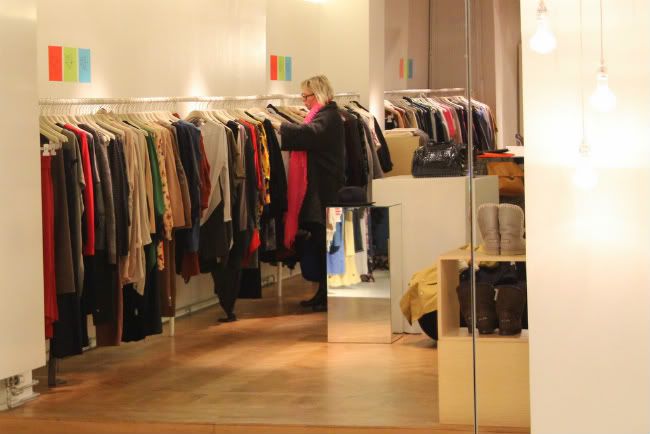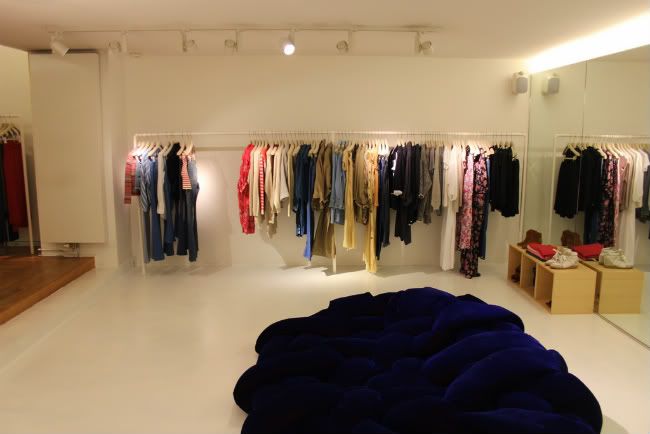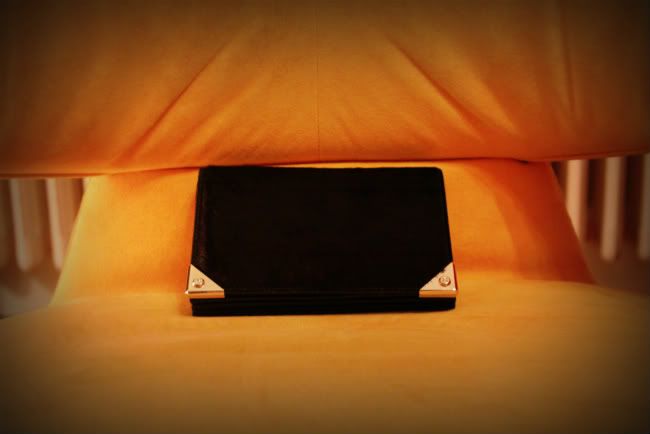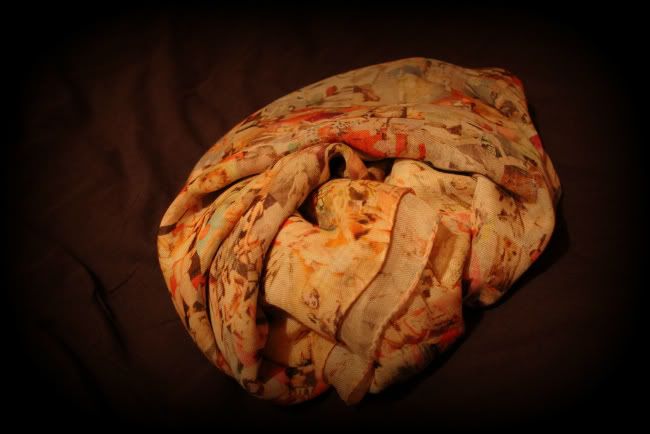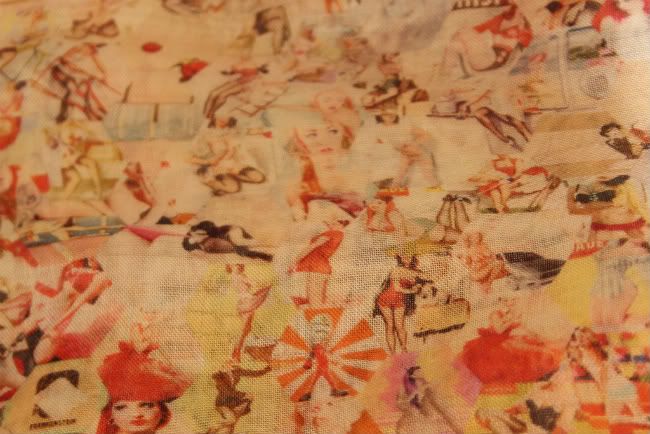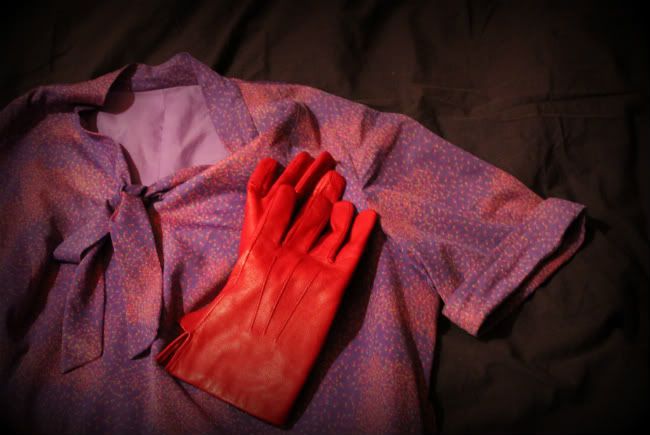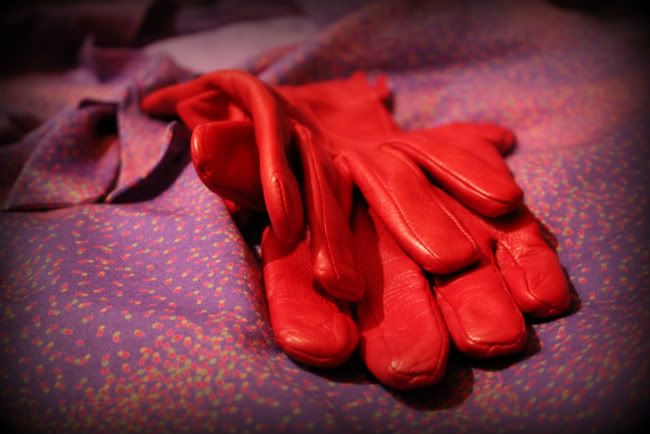When I was a teenager, I passed by Icon on a daily basis, and yet it couldn't have been more removed from my own small sartorial world. (From 12 to 16 I bought H&M and a few fugly second hand finds, that was about it. Oh, and Brantano shoes! Now those were the days.) An acquaintance used to call Icon and the store next to it (now Hallelujah, a shop for ecological fashion; I don't remember the name back then but it sold Yoshi Yamamoto and the likes) 'the shops where nobody ever enters'. How they survived was a mystery to us, for 5 years long we didn't see as much as one soul venture inside.
This week I finally set foot in Icon. The window display looked original and alluring. Instead of showcasing clothing, an enchanting piece of art occupies the window. Obviously Icon doesn't really thrive on drawing in bypassers: their customers are more of the well-informed fashionista set (although we saw people of all ages and styles wandering inside).
Seen from the inside. The name of the artist was on their (frequenty updated) facebook page, but now I can't seem to find it.
I have a weak spot for light design - instant love for the lamps on the right.
The shop is larger than you'd expect from the outside: it runs all the way to the back, where a spacious room accomodates the dressing rooms. The big slouchy couch looks like a great prop for exhausted partners or co-shoppers. I didn't try it out, but boy did I want to. If I would own something like this, I would use it to host futuristic tea parties and movie nights on it every week:
The art and attention for detail is what makes Icon's interior stand out. This piece of art next to the dressing rooms makes me think of Marcel Duchamp, constructivism and cubism at the same time:
The trompe l'oeil embodies a certain playfulness you find in the store, I think. Beauty, thoughtful design, meant to have fun with. They sell brands like Acne, Isabel Marant , Phillip Lim and Vanessa Bruno, but also lesser-known designers. The garments go from classic to bold to statement with the snap of a finger. Icon is nowhere as stiff as my teenage self imagined it to be. The staff is well-informed and helpful - although I might be a bit prejudiced, because one of them actually went to school with me.
I bought two things, one of which can be justified by its functionality, the other by its sheer genius. The first is a wallet from Alexander Wang. My wallet was stolen about a year ago, and I've been using a borrowed one ever since. From my boyfriend's mother - who was excellent taste. When I saw this baby, I knew it was time to stop hoarding her possessions:
Told you I have a thing for lamps.
And books. Did I mention books?
I bought this wallet before I wrote my previous post on not buying anything produced outside of the EU. I only found out yesterday that Alexander Wang products proudly wear a 'Made in China'-label. At least he's not trying to hide it like so many other designers, but it still bummed me out.
The other object is a scarf from Unbreakable Evolution. It's slightly tacky, it's amazing, it's a little scandalous but not so that I can't wear it to work. It's a cashmere and silk blend with the most awesome. print. ever. (I've never owned anything cashmere before. Why didn't anyone bother to tell me it's like wearing sunlight spun to a delicate chiffon feeling?)
Unbreakable evolution is an Italian brand, but the label doesn't mention where it was made, which makes me fear the worst. I technically wasn't bound by my resolution at the moment I bought it, but it still feels like I flaked out. That doesn't stop me from enthusiastically pointing out to people I'm wearing a cloud of half-naked women around my neck. Super classy!
Thursday, January 5, 2012
Wednesday, January 4, 2012
2012 Shopping Manifesto
Well howdy-do 2012. Happy New Year! I hope you all enjoyed some jolly holidays. Mine were filled with travel (London!), lots of food (lobster breakfast anyone?), The Killing (I just discovered Sarah Lund's sweater has its own website), sleeping in (up until 4 pm on january 1st, definitely a personal record) and spending time with loved ones. Oh, and some beautiful presents, among which a vintage Joan-esque dress and Hobbs gloves:
Tell me, do you have any big plans for 2012? An hour or so after the countdown to the new year, my friends and I found ourselves discussing New Year's resolutions. I can't recollect ever having made serious resolutions at the beginning of a new year, and Saturday night was no exception. I'm no out of control Lindsay Lohan, but I'm definitely not an epitome of self control either, so there just didn't seem a point, really. That's why I cheerfully omitted the poisonous cup of guaranteed failure without even thinking of sipping.
However! I've been thinking about committing myself despite all of the above. What I've been thinking about is not as much a resolution as it is a project or - put a tad more grandiloquently, as fits a grand idea (ha) - a personal shopping manifesto. Why the change of heart? Writing this blog makes me conscious of the way I buy and wear clothes. It presented me with some much-needed insights in my impulse buying, overspending and lack of consistency. It also made me take a closer look at other bloggers' shopping habits, some of which annoyed me to no end. The use of some terms, advice and general statements seriously got on my nerve. I won't bore you with examples, except this one:
Designer stuff is too expensive for me, I can only afford high street clothing.
I don't mean to offend anyone, but I. am. so. sick of this. This statement is usually embedded in an endless loop of H&M/Zara/Mango/F21/Primark-outfit pictures. If you have 40 pairs of cheap shoes and can afford to go shopping twice a month, maybe money is not your problem. Maybe (impulse) spending is.
Easily said, right? Hugh Latimer once stated: the maid's child is ever best taught. The man may have gotten burnt at the stake, but that doesn't mean he didn't have a point - or a distinct sense of fashion, while we're at it:
Puff sleeves! A collar! A baret! A sleeveless parka! If anything, he was man repelling. What Hugh meant to say is: it's easy to pass judgement on other people's behavior. It's easy to shout out criticism from the sideline. I know I'm pointing fingers, but I promise I'm just as critical of myself.
A dress for 150 euros might seem utterly expensive, frivolous, or even wasteful when you're used to spending somewhere between 15 and 50 euros on garments. Of course it does. But taking an honest look at our closets, most of us will probably have to admit that they are overflowing with stuff we don't really need. What would the cost of all that count up to? For instance, I would guess I have about 25 dresses. Except for one exception, none of them were bought for less than 20 euros. Some of them cost about a 100 euros. Say I have about 5 expensive dresses, 15 not too cheap but not too expensive ones and 10 that cost me anywhere between 20 and 30 euros. That sums up to a nice 1500 euros at the very least - surely a sum good enough to buy a number of well designed dresses made in good circumstances with durable and pleasant fabric.
Troughout my teenage years, I had a shopping budget of 25 euros a month. I never found myself able to build a wardrobe and was always wanting for new things, to fill some or other sartorial gap. I can easily afford to multiply that budget these days, and yet the time I spend thinking I don't have anything to wear has not decreased one bit. This is caused by two problems: lack of vision and fast consumption. It's a bitch of a vicious circle, basically. I buy things I like without considering how they can be incorporated into my wardrobe. As a consequence, I have to buy new things to be able to wear them. For this I often resort to cheap alternatives.
Time to put an end to this idiotic habit. The clothes we buy might come cheap to us, but this usually means they cost someone else a great deal. When we buy bad quality clothing, people - generally our mothers - tell us that we got what we payed for. As a matter of fact, it's much worse: we also made sure someone else wasn't payed properly for the job he or she did. I often wonder how the hell it's possible that chains can sell a pair of jeans for 20 euros. This means that after the cost of the material, labor, transport, rent, marketing and wages of personnel they still make profit. HOW on earth is that possible? Obviously costs are cut on two fronts:
- Quality and sustainability of materials
- The wages of the people making the clothes
Inspired by Lucy Siegle, this post and this article, I decided I no longer want to be part of blantant fashion abuse, be it ethically or ecologically. Following all that, my goal for 2012 is threefold:
- Not to buy anything from high street shops such as H&M, C&A, F21, Sacha, Zara, New Look, ...
- Only buy clothing produced within the EU. Exceptions can be made when good working circumstances are guaranteed (for instance fair trade products, local projects, etc.).
- Restrict impulse buying. Make sure that what I buy fits in with my wardrobe; plan what to buy; think more thouroughly about looks before going shopping. Spend more money on basics, less on frills.
I will allow myself one exception to these rules, being pantyhose. I only own two pair of pants, so I need plenty of pantyhose. I always stick to the same brand (Cette), because in my experience, they're the only ones that aren't too short. (A length of 6 ft comes with its own costs.) I'm not quite prepared to give them up. If anyone knows where to find great pantyhose for tall women, I'll be happy to hear about it.
So that's that. I'll post further thoughts and findings here, if only to make myself stick to the plan. I have to admit, it's a little exciting, the whole resolutions thing!
Tell me, do you have any big plans for 2012? An hour or so after the countdown to the new year, my friends and I found ourselves discussing New Year's resolutions. I can't recollect ever having made serious resolutions at the beginning of a new year, and Saturday night was no exception. I'm no out of control Lindsay Lohan, but I'm definitely not an epitome of self control either, so there just didn't seem a point, really. That's why I cheerfully omitted the poisonous cup of guaranteed failure without even thinking of sipping.
However! I've been thinking about committing myself despite all of the above. What I've been thinking about is not as much a resolution as it is a project or - put a tad more grandiloquently, as fits a grand idea (ha) - a personal shopping manifesto. Why the change of heart? Writing this blog makes me conscious of the way I buy and wear clothes. It presented me with some much-needed insights in my impulse buying, overspending and lack of consistency. It also made me take a closer look at other bloggers' shopping habits, some of which annoyed me to no end. The use of some terms, advice and general statements seriously got on my nerve. I won't bore you with examples, except this one:
Designer stuff is too expensive for me, I can only afford high street clothing.
I don't mean to offend anyone, but I. am. so. sick of this. This statement is usually embedded in an endless loop of H&M/Zara/Mango/F21/Primark-outfit pictures. If you have 40 pairs of cheap shoes and can afford to go shopping twice a month, maybe money is not your problem. Maybe (impulse) spending is.
Easily said, right? Hugh Latimer once stated: the maid's child is ever best taught. The man may have gotten burnt at the stake, but that doesn't mean he didn't have a point - or a distinct sense of fashion, while we're at it:
Puff sleeves! A collar! A baret! A sleeveless parka! If anything, he was man repelling. What Hugh meant to say is: it's easy to pass judgement on other people's behavior. It's easy to shout out criticism from the sideline. I know I'm pointing fingers, but I promise I'm just as critical of myself.
A dress for 150 euros might seem utterly expensive, frivolous, or even wasteful when you're used to spending somewhere between 15 and 50 euros on garments. Of course it does. But taking an honest look at our closets, most of us will probably have to admit that they are overflowing with stuff we don't really need. What would the cost of all that count up to? For instance, I would guess I have about 25 dresses. Except for one exception, none of them were bought for less than 20 euros. Some of them cost about a 100 euros. Say I have about 5 expensive dresses, 15 not too cheap but not too expensive ones and 10 that cost me anywhere between 20 and 30 euros. That sums up to a nice 1500 euros at the very least - surely a sum good enough to buy a number of well designed dresses made in good circumstances with durable and pleasant fabric.
Troughout my teenage years, I had a shopping budget of 25 euros a month. I never found myself able to build a wardrobe and was always wanting for new things, to fill some or other sartorial gap. I can easily afford to multiply that budget these days, and yet the time I spend thinking I don't have anything to wear has not decreased one bit. This is caused by two problems: lack of vision and fast consumption. It's a bitch of a vicious circle, basically. I buy things I like without considering how they can be incorporated into my wardrobe. As a consequence, I have to buy new things to be able to wear them. For this I often resort to cheap alternatives.
Time to put an end to this idiotic habit. The clothes we buy might come cheap to us, but this usually means they cost someone else a great deal. When we buy bad quality clothing, people - generally our mothers - tell us that we got what we payed for. As a matter of fact, it's much worse: we also made sure someone else wasn't payed properly for the job he or she did. I often wonder how the hell it's possible that chains can sell a pair of jeans for 20 euros. This means that after the cost of the material, labor, transport, rent, marketing and wages of personnel they still make profit. HOW on earth is that possible? Obviously costs are cut on two fronts:
- Quality and sustainability of materials
- The wages of the people making the clothes
Inspired by Lucy Siegle, this post and this article, I decided I no longer want to be part of blantant fashion abuse, be it ethically or ecologically. Following all that, my goal for 2012 is threefold:
- Not to buy anything from high street shops such as H&M, C&A, F21, Sacha, Zara, New Look, ...
- Only buy clothing produced within the EU. Exceptions can be made when good working circumstances are guaranteed (for instance fair trade products, local projects, etc.).
- Restrict impulse buying. Make sure that what I buy fits in with my wardrobe; plan what to buy; think more thouroughly about looks before going shopping. Spend more money on basics, less on frills.
I will allow myself one exception to these rules, being pantyhose. I only own two pair of pants, so I need plenty of pantyhose. I always stick to the same brand (Cette), because in my experience, they're the only ones that aren't too short. (A length of 6 ft comes with its own costs.) I'm not quite prepared to give them up. If anyone knows where to find great pantyhose for tall women, I'll be happy to hear about it.
So that's that. I'll post further thoughts and findings here, if only to make myself stick to the plan. I have to admit, it's a little exciting, the whole resolutions thing!
Subscribe to:
Comments (Atom)


